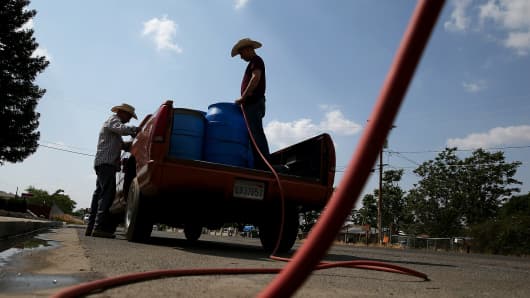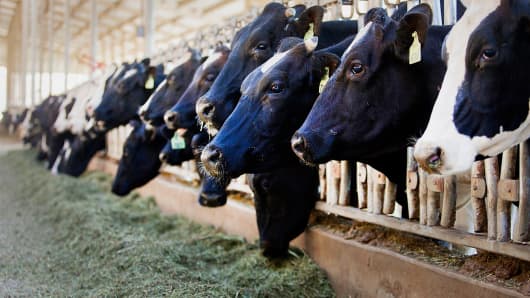 Forecast calls for $1.8 billion in farm revenue losses…
Forecast calls for $1.8 billion in farm revenue losses…
Vast tracts of farmland—mostly in the Central Valley—have been fallowed, which means idled to accumulate moisture. An estimated 564,000 acres will be idled, according to an economic update on the drought from researchers at the University of California at Davis.
Unused land, of course, triggers lower agricultural output. Based on estimates of 564,000 idled acres, farm revenue losses are forecast at $1.8 billion, and 8,550 fewer farm jobs because of the drought.
The ripple effect of lower agricultural activity is forecast to be even bigger. Idled land means fewer food processing jobs and thin ranks of truckers to haul goods. Spillover, statewide revenue losses are likely to reach $2.7 billion with 18,600 lost full-time and part-time jobs, according to the report.
“This is a very extreme drought,” said Daniel A. Sumner, agricultural economist at UC Davis, and editor of the update released earlier this week. The report includes economic analysis of drought data from May and June.
More idled land
But already researchers think 564,000 idled acres may be too low an estimate.
According to a separate June report from the U.S. Department of Agriculture, state acreage of principal crops—which includes field crops such as hay, grains, cotton and potatoes—is running about 900,000 acres or 22.5 percent below the 2013 total of about four million acres.
“Land is incredibly productive,” Sumner said. “Nobody leaves land idle unless something really bad happens.”
“Things are really day-to-day for the wells …”
From big cities to rural communities, year four of a historic drought is shaping water consumption habits statewide. Gov. Jerry Brown in April mandated a 25 percent cut in urban water use—the first ever for California. In San Francisco, for example, home cooks and restaurant chefs are tweaking kitchen rituals such as reducing free-flowing water over vegetables. Watering a home lawn during non-designated times can get you hundreds of dollars in fines.
Deep in agricultural counties, farmers are churning through the summer heat with little to no surface water supplies and digging deeper for groundwater—water buried underneath the earth’s surface. Groundwater flows naturally to the top, or can be pumped to the surface through wells.
Like dipping into a savings account, groundwater can account for half of total state water consumed in drought years.
More groundwater is being pumped at a faster pace than groundwater sources can replenish their moisture levels. In 2014 and 2015, farmers will have pumped at least 11 million acre-feet of additional groundwater to make up for lost surface supplies, according to UC Davis. (An acre-foot is roughly 325,000 gallons of water. Just imagine a swimming pool that’s an acre across and a foot deep.)
After decades of groundwater extraction, pockets of land have been sinking from Merced down to Bakersfield—at first by inches, and now by feet.
Read MoreRising tensions over monitoring groundwater
One of the hardest hit drought areas in the Central Valley is Tulare County, where roughly 1,000 private well failures have forced hundreds of rural residents to use buckets and temporary sources of water to bathe, cook and clean.
“Things are really day-to-day for the wells holding up,” said Marilyn Kinoshita, Tulare County’s agricultural commissioner.
Sector breakdown of losses
- Rice farmers are planting about 30 percent less rice this year, according to the California Rice Commission.
- The dairy and cattle industries are forecast to lose $350 million in revenues, according to UC Davis research.
The dairy industry is getting hit from all sides. The economy of China, a big U.S. dairy consumer, has slowed. Meanwhile, dairy farmers are paying for higher feed prices as hay farmers have lowered production due to water shortages.
Said Sumner: “Dairy is in a world of hurt right now.”
Source: http://www.cnbc.com/2015/07/09/revenue-loss-due-to-california-drought-to-top-1-billion.html


